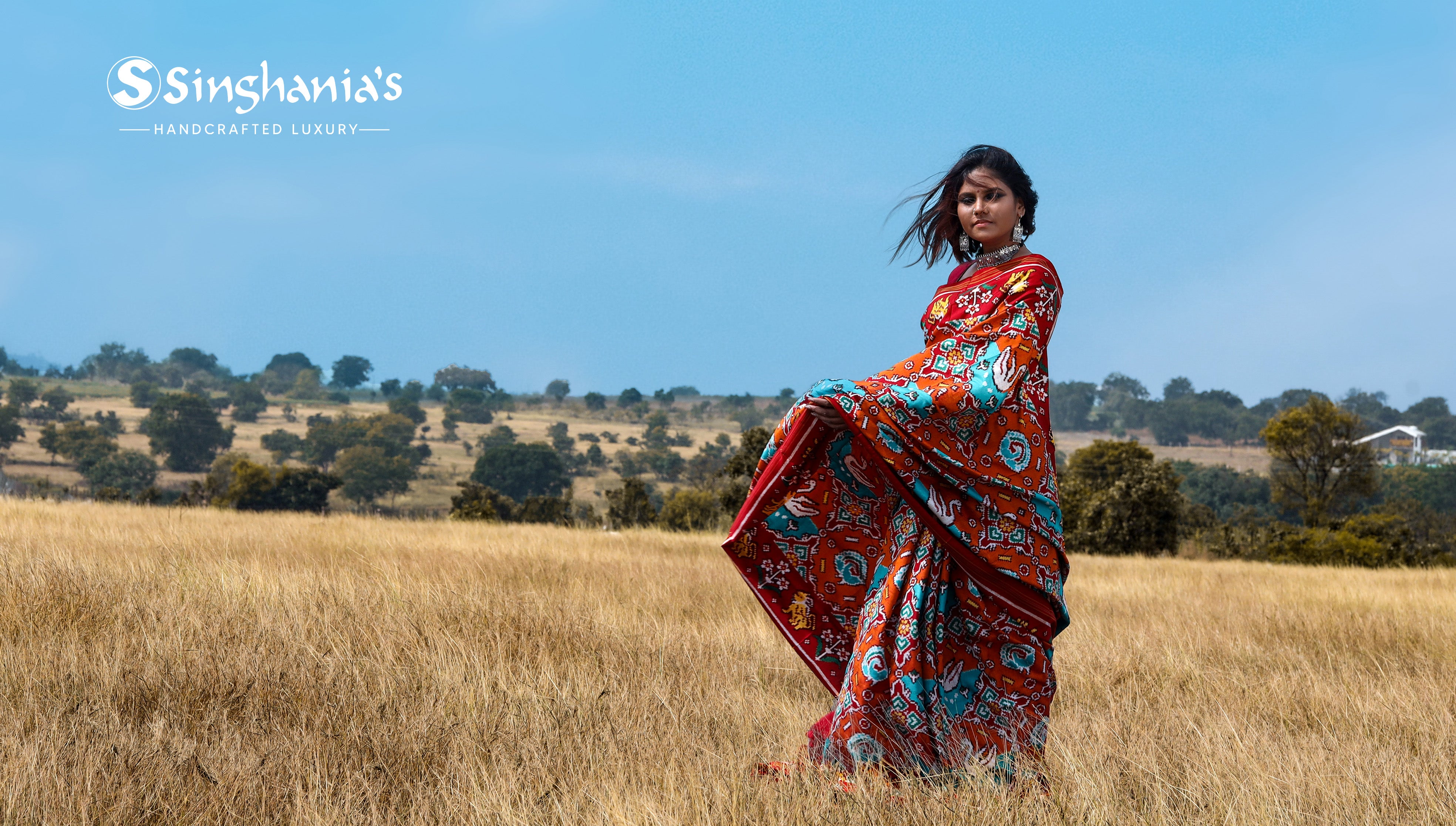
Ikat silk is a captivating textile art form that has been an integral part of India's rich cultural heritage for centuries. This unique type of ikkat silk is created using a specialised dyeing technique that produces intricate, mesmerising patterns.
The origins of Ikat silk can be traced back to ancient times, with roots firmly embedded in the traditions and craftsmanship of various communities across the Indian subcontinent. The term "Ikat" itself comes from the Malay word "mengikat," meaning "to bind, tie, or wind around," reflecting the intricate process involved in creating these distinctive designs.
Ikat silk has long been celebrated for its cultural significance and artistic beauty, making it a treasured part of India's textile heritage.
Diverse Ikat Dyeing Techniques
The key to creating beautiful Ikat silk is the special dyeing process used. This involves a technique called resist-dyeing. In this method, the silk threads are carefully wrapped or bound using materials like bamboo or jute before being dyed. The bound parts of the threads stay uncolored, while the exposed areas soak up the vibrant dyes, resulting in the intricate Ikat patterns.
Across different regions of India, Ikat artisans have developed their own unique variations of this resist-dyeing technique. In Odisha, the Sambalpuri Ikat Sarees are made using a "Bandha" method, where the warp threads (the lengthwise threads) are meticulously tied and bound before dyeing.
The Ikat Patola Sarees of Gujarat showcase an even more complex double-Ikat technique. Here, both the warp and weft threads (the crosswise threads) are individually resist-dyed before being woven together.
Meanwhile, the Pochampally Ikkat Silk Sarees of Telangana use a distinct "Punnami" method, where only the warp threads are resist-dyed, while the weft threads remain in their natural state.
These diverse Ikat silk dye techniques, each with their own unique artistic touches, have all contributed to the rich tradition of Ikat silk in India, showcasing the incredible skill and craftsmanship of artisans across the country.
Ikkat Silk Origins and Varieties:
Now let's take a closer look at the regional characteristics of these captivating ikkat silk saree crafts. Starting in the eastern state of Odisha, the Sambalpuri Ikat Sarees are deeply rooted in the local culture and environment. The vibrant color palettes often draw inspiration from the region's lush natural landscapes, with deep indigos, earthy reds, and vibrant greens featuring prominently. The intricate geometric motifs are also heavily influenced by traditional Orissan design sensibilities.
Moving westward to Gujarat, the Ikat Patola Sarees showcase a unique "double ikat" technique where both the warp and weft threads are meticulously tie-dyed prior to weaving. This painstaking process creates the sarees' signature interlocking patterns, a hallmark of Gujarati textile artistry.
Meanwhile, in southern India's Telangana state, the Pochampally Ikkat Silk Sarees exhibit a more delicate, floral aesthetic, with intricate patterns woven into the luxurious silk fabric using natural dyes like turmeric. The muted, earthy color tones are quintessentially Telangana. Each of these regional ikat traditions thus reflects the distinct cultural identities and natural environments of their respective states.
Ikat Silk in Fashion
Ikat print sarees have become a fashionable contemporary trend, blending traditional textile techniques with fresh, modern designs. These beautiful patterned silk ikat fabric are no longer confined to just special occasions - they are being worn for a wide variety of events and settings. The vibrant, eye-catching ikat prints add a stylish, distinctive touch whether the saree is being worn casually for daily wear or dressed up for weddings and parties. The versatility of ikat silk makes it suitable for all kinds of attire, from relaxed everyday outfits to formal, occasion-wear.
Fashion designers are also experimenting with ikat silk fabric, incorporating the traditional patterns into cutting-edge garment designs beyond the classic saree. This has helped ikkat silk material transcend its heritage roots and become a celebrated part of mainstream Indian fashion today.
Procuring Ikat Silk
If you're interested in getting your hands on some beautiful ikat silk fabric online, there are plenty of options available these days, especially online. You can find ikat silk fabric by the yard to use for sewing your own garments, or you can purchase ready-made ikat silk sarees. When looking to buy, there are a few key things to keep in mind.
First, consider the specific ikat tradition you're interested in, whether it's the vibrant Sambalpuri Ikat Sarees from Odisha or the intricate double-ikat Ikat Patola sarees from Gujarat. This will help you find authentic, high-quality pieces. Also, pay attention to the fabric quality and dyework - true ikat silk should have a gorgeous luster and the patterns should be crisp and clear. It's a good idea to buy from reputable, specialized ikat retailers, whether online marketplaces or directly from traditional artisan workshops. This way, you can be sure you're getting the real deal. With a little research, you can find stunning, one-of-a-kind ikat silk fabric and garments to add to your wardrobe.
Ikat silk's beauty goes far beyond its stunning appearance. It's a living tradition, a story woven into every thread. By understanding the dedication of the artisans, the unique techniques used across India, and the rich cultural symbolism in the patterns, we gain a deeper appreciation for this art form. Owning an ikat silk piece isn't just about wearing a pretty fabric; it's about carrying a piece of history and cultural heritage. If you're looking to experience the magic of ikat silk for yourself, Singhania's is a great place to start. They offer authentic, high-quality ikat silk creations that let you adorn yourself in this timeless art form, while also supporting the communities that keep this incredible tradition alive.
